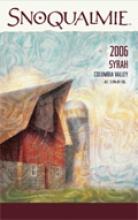Wineries without Websites
I'm loving trying Washington wines, and learning about the various vineyards, and wineries, and winemakers. There are lots of wonderful resources on the Web for Washington wine, ranging from blogs like Sean Sullivan's Washington Wine Report, Wahington Wine Wench's Write for Wine, Terry Christiani of The Winos, Bloggers of Washington Wine (BOWW), and Wild 4 Washington Wine, to larger, more general Washington wine sites like the Washington Wines Commission and Wines Northwest and Go Taste Wine. But there are far too many of the more than 600 Washington wineries that have no Web site at all, or a frustrating placeholder page.
Rulo winery, which I keep hearing lovely things about, has no Web site. I can glean some information from reviews, and this page, but while there's a rulo.com domain reserved, it's a squatter site. Richard Fairfield's amazing boutique winery Cedar Ridge is another with a domain, and no site. ETA: Rulo winery has page now, here.
I do realize that the intense effort and all-consuming demands of running a winery preclude having the time or the money to spend on a Web site. But a Web site in the 21st century is no longer a luxury; it's a requirement. It can be as basic as the elegant but effective Goose Ridge Winery site. It's a simple but extremely effective Web site. You can create a Web site entirely using free software; and, with certain restrictions, you can even avoid server fees. Bluntly put, a Web site allows you direct contact with your customers, and with potential customers. You can provide not only the obvious information: who you are, the wines you make, how to locate the winery, your event and tasting schedules, where to find your wines. You can even avoid direct mail costs by creating elegant, informative html newsletters. Many wineries email an occasional newsletter; the Columbia Crest newsletter is an excellent model; it's straightforward, informative, and attractive.
Most importantly of all, using the Web, you can create a virtual community for you and your customers. A blog is one of the easiest and most effective marketing and outreach tools you have; you can quickly easily let people know what you're doing, or the great press you've just received, or link to another blog with a positive review—and your customers can respond via the blog's comment feature. Your customers are your best wine evangelists; they like your wines, they're enthusiastic about them, and they will serve to inform those who aren't yet customers.
There's an awful lot of hype, and foolishness, and spam related to marketing using the Web. Ignore most of what you've heard or been told; it isn't cheaper, or easier, or faster. What the Web allows you to do is have the kind of conversations you have with your customers when they come to your tasting room—even when they're 3,000 miles away. There's a really famous book about how the Web works in terms of communicating (which is what you want to do with customers) called The Cluetrain Manifesto; it's about to be updated in a second edition in June, so don't rush out and buy it now. But you can read some samples here. One of the most important points The Cluetrain Manifesto makes is
A powerful global conversation has begun. Through the Internet, people are discovering and inventing new ways to share relevant knowledge with blinding speed. As a direct result, markets are getting smarter--and getting smarter faster than most companies.
These markets are conversations.
You can use the Internet, including your Web site, and social networking sites, and Twitter to start, and continue conversations with your customers. Think of the Web as a series of places, of neighborhoods, even. Twitter is one neighborhood, and it connects to others—especially blogs. Conversations spill over and around the various neighborhoods; they move from Twitter to blogs, to Facebook (another social network), and back, and offline to the office and to the woman at the market who asked which Cabernet I liked the best. By interacting with your customers, and providing a way for them to interact with each other, you create community, a community built around a common interest in your wine.
Part of the beauty of conversations on the Internet, the conversations are many-to-many; they don't stop with you providing a fact sheet to your customers; they continue, if you're a good host, because your customers continue the conversation without you—ideally, over glasses of wine with their friends, real and virtual. For instance; wine blogger Sean Sullivan has a monthly "virtual tasting." He selects a particular wine several weeks in advance, announces the selected wine, and the time for the virtual tasting, and his readers buy the wine, and then, we all try it at the same time, and discuss it on his blog via the Comments.
If you seriously just don't have the funds, or don't have a clue about where to start, even a free site on Blogger or Google Sites or LiveJournal would help enormously. FaceBook is free, and there are already several FaceBook groups for people interested in Washington Wine. If I were a Washington winery of any size at all, I'd get a free Twitter account, and make announcements about when I'm harvesting, what wines I'm releasing, what wines have received reviews, as sort of micro press releases. I note that I'm not the only Washington Wine blogger on Twitter, either. There are a fair number of us blogging about Washington wine; make it easy for us and for your other customers to follow your wines and your winery.


